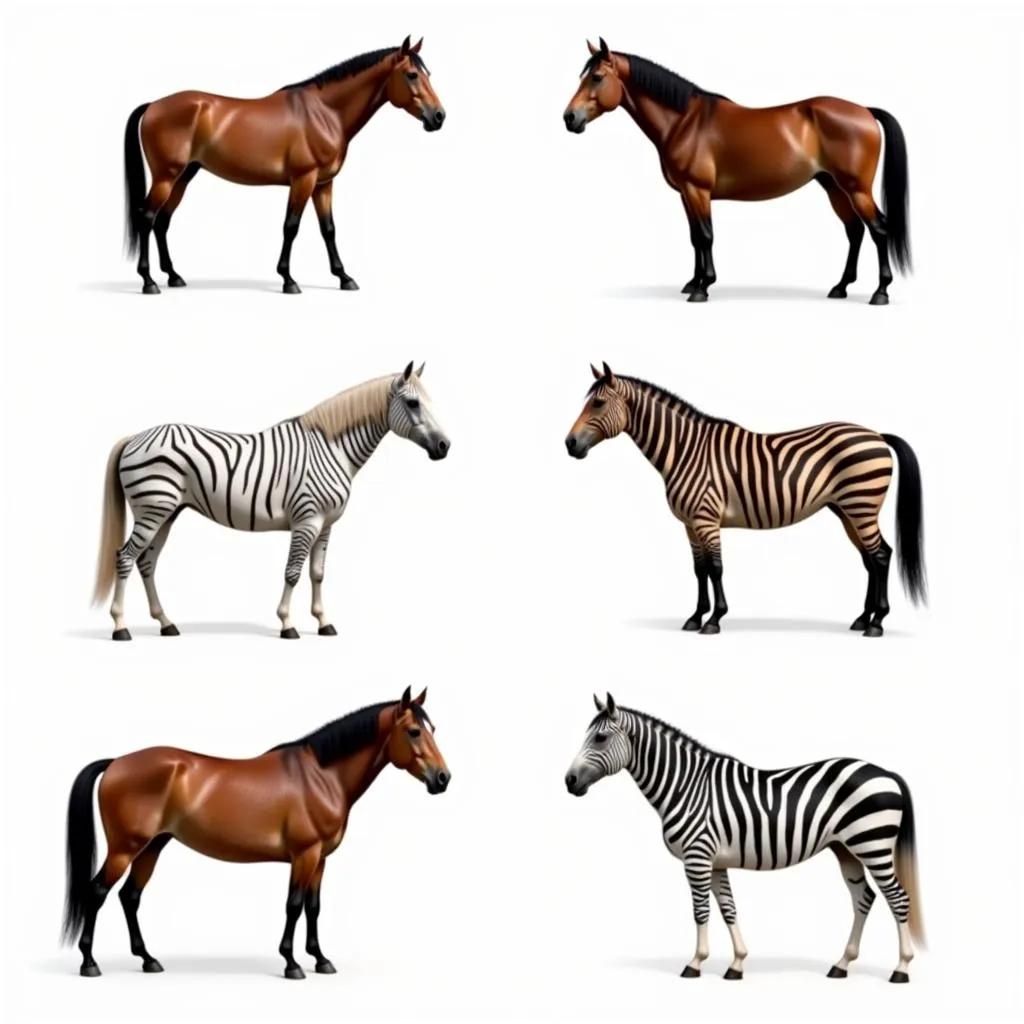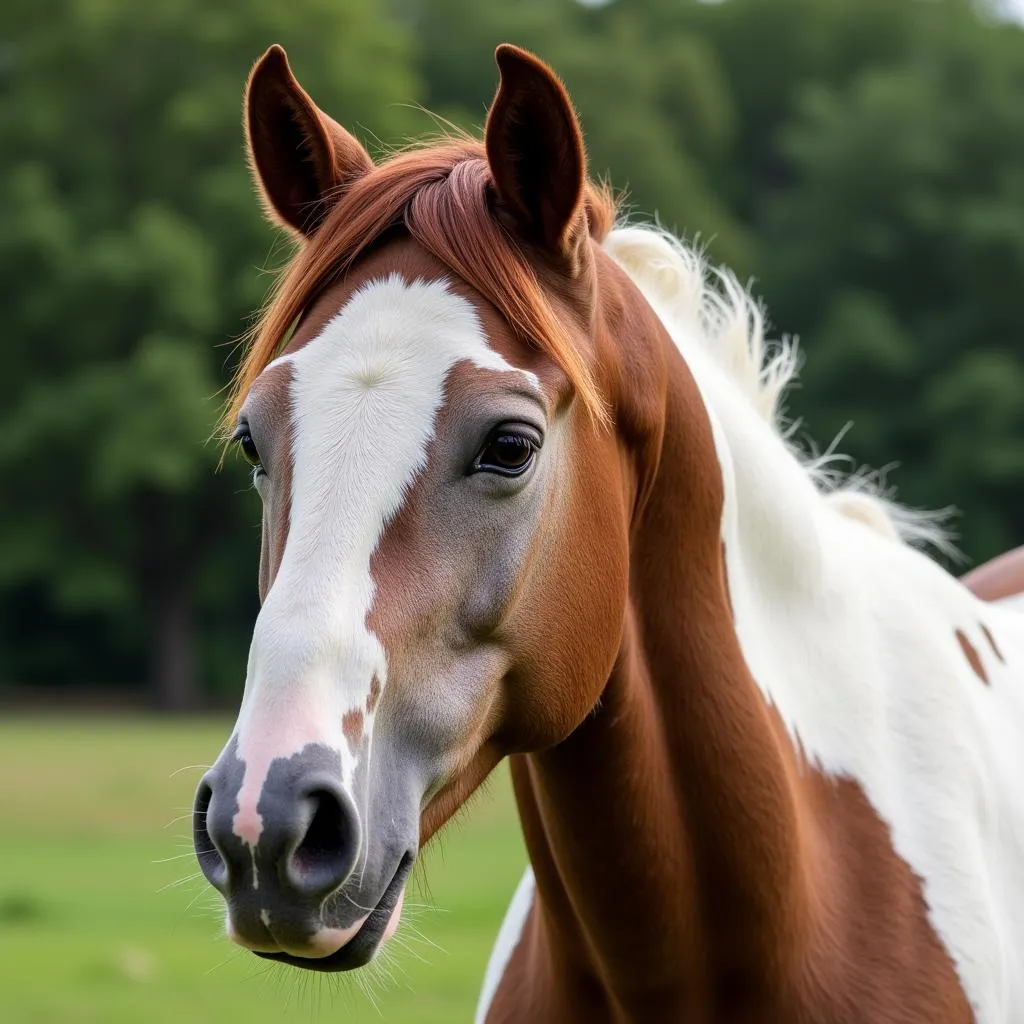Stripy Horses are a fascinating breed that captivates horse enthusiasts with their unique coat patterns. These stripes, often referred to as “zebra stripes” or “dappling,” add a touch of intrigue and beauty to the equine world. This article delves into the world of stripy horses, exploring the different types of stripe patterns, their genetic origins, and the impact on their health and care.
Stripy horses are a testament to the diverse and intricate nature of equine genetics. The coat patterns, ranging from subtle dapples to bold stripes, are the result of specific gene interactions and pigment distributions. Understanding these patterns can shed light on a horse’s ancestry, breed characteristics, and even potential health conditions.
What Causes Stripy Horse Coats?
The stripes on a horse’s coat are primarily attributed to the agouti gene, a genetic factor that regulates the distribution of pigment in the hair. Different variations of this gene lead to diverse coat patterns, including:
- Dappling: Often seen in horses with bay, chestnut, and brown coats, dappling involves small, irregular stripes that create a speckled or freckled effect.
- Stripes: More pronounced than dappling, stripes can be found in various breeds and can be vertical, horizontal, or even spiral-shaped.
- Zebra Stripes: These striking stripes are primarily found in the Przewalski’s horse, the only true wild horse species, and some domestic breeds that share similar genetics.
Understanding the Agouti Gene and Coat Patterns
The agouti gene has multiple alleles, each contributing to a specific coat pattern. For example, the A^w allele is responsible for the classic “wild” bay coat with a black mane and tail and a reddish body. This allele can also cause the dappling effect.
Another important gene involved in coat pattern is the Extension gene, which controls the production of black pigment. The E^e allele reduces black pigment, resulting in the bay coat. Horses with the E^e allele are more likely to exhibit dappling or stripes due to the lighter base color.
The Role of Genetics in Stripy Horse Coats
The presence of stripes and dappling is often influenced by a horse’s breed and ancestry. Some breeds, like the Appaloosa, are known for their distinctive patterned coats, while others, like Thoroughbreds, are typically solid-colored.
Health Implications of Stripy Horse Coats
While stripy horse coats are generally considered a cosmetic trait, they can sometimes be associated with certain health conditions.
Leptospirosis in Horses:
Leptospirosis, a bacterial disease, can sometimes manifest as dappling or striping in horses. This is due to the disease causing damage to the blood vessels, leading to patchy areas of pigment deposition. However, it’s important to note that not all horses with dappling or stripes have leptospirosis.
Other Potential Health Conditions:
While less common, other health conditions can also affect a horse’s coat pattern, including:
- Hormonal imbalances: Hormonal fluctuations can sometimes cause temporary changes in coat color, including dappling or striping.
- Nutritional deficiencies: A lack of essential nutrients, like copper and zinc, can impact pigment production and cause irregular coat patterns.
Caring for Stripy Horses
Caring for stripy horses doesn’t differ significantly from caring for other horses. However, certain considerations can be beneficial:
- Sun Protection: Horses with light-colored coats, including those with extensive stripes, may be more sensitive to sunburn. Providing shade and using sunscreen can be helpful.
- Coat Maintenance: Maintaining a healthy coat can enhance the beauty of stripes. Regular grooming, proper nutrition, and parasite control are essential.
Frequently Asked Questions About Stripy Horses:
Q: Can a stripy horse coat change over time?
A: While a horse’s coat pattern is primarily determined by genetics, some changes can occur over time. These can be due to factors like age, seasonal variations, or underlying health conditions.
Q: Is it possible to breed for stripy horses?
A: Yes, selective breeding can increase the chances of producing offspring with stripes. Understanding the genetics of coat patterns is crucial for successful breeding programs.
Q: What are the most popular breeds known for their stripy coats?
A: Some popular breeds known for their stripy coats include:
- Appaloosa
- Pinto
- Paint
- Quarter Horse
Q: What are the different types of stripe patterns?
A: Stripe patterns can vary greatly, with some of the most common types including:
- Vertical Stripes: These run from the horse’s head to its hindquarters.
- Horizontal Stripes: These run across the horse’s body, often forming a band-like pattern.
- Dapples: Small, irregular stripes that give the coat a speckled or freckled effect.
- Spiral Stripes: These striking patterns often occur on the horse’s chest or flanks.
Stripy horses are a testament to the diversity and beauty found in the equine world. By understanding their genetic origins and coat patterns, we can appreciate their uniqueness and provide them with the best possible care.
 Stripy horse coat patterns
Stripy horse coat patterns
 Appaloosa with a stripy coat
Appaloosa with a stripy coat
 Dappled horse coat
Dappled horse coat
Remember, if you have any questions about stripy horses or any other horse-related concerns, don’t hesitate to contact us. We are here to provide you with the information and support you need to be a responsible and knowledgeable horse owner. You can reach us at:
Phone: 0772127271
Email: [email protected]
Address: QGM2+WX2, Vị Trung, Vị Thuỷ, Hậu Giang, Việt Nam.
We are here for you 24/7!